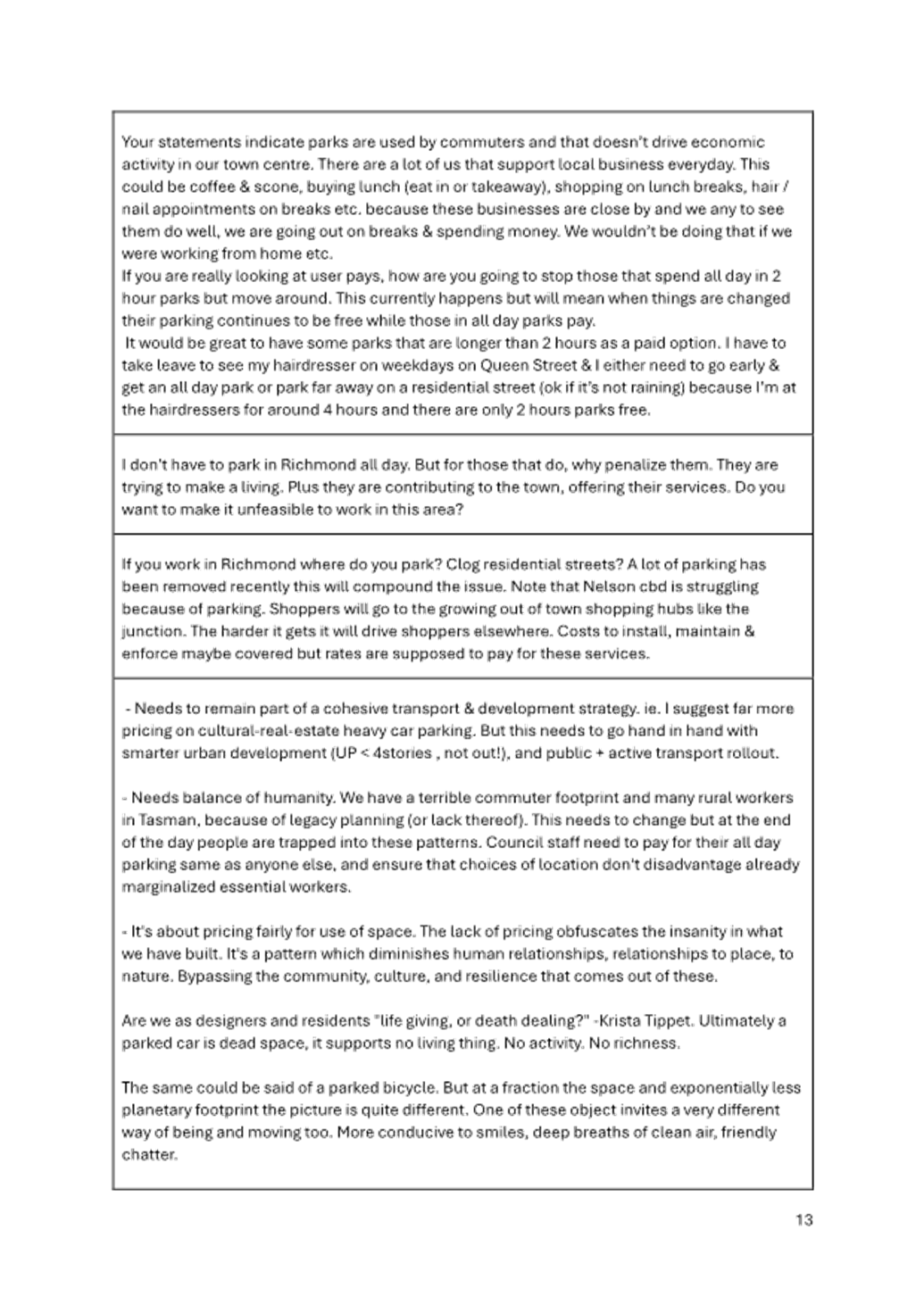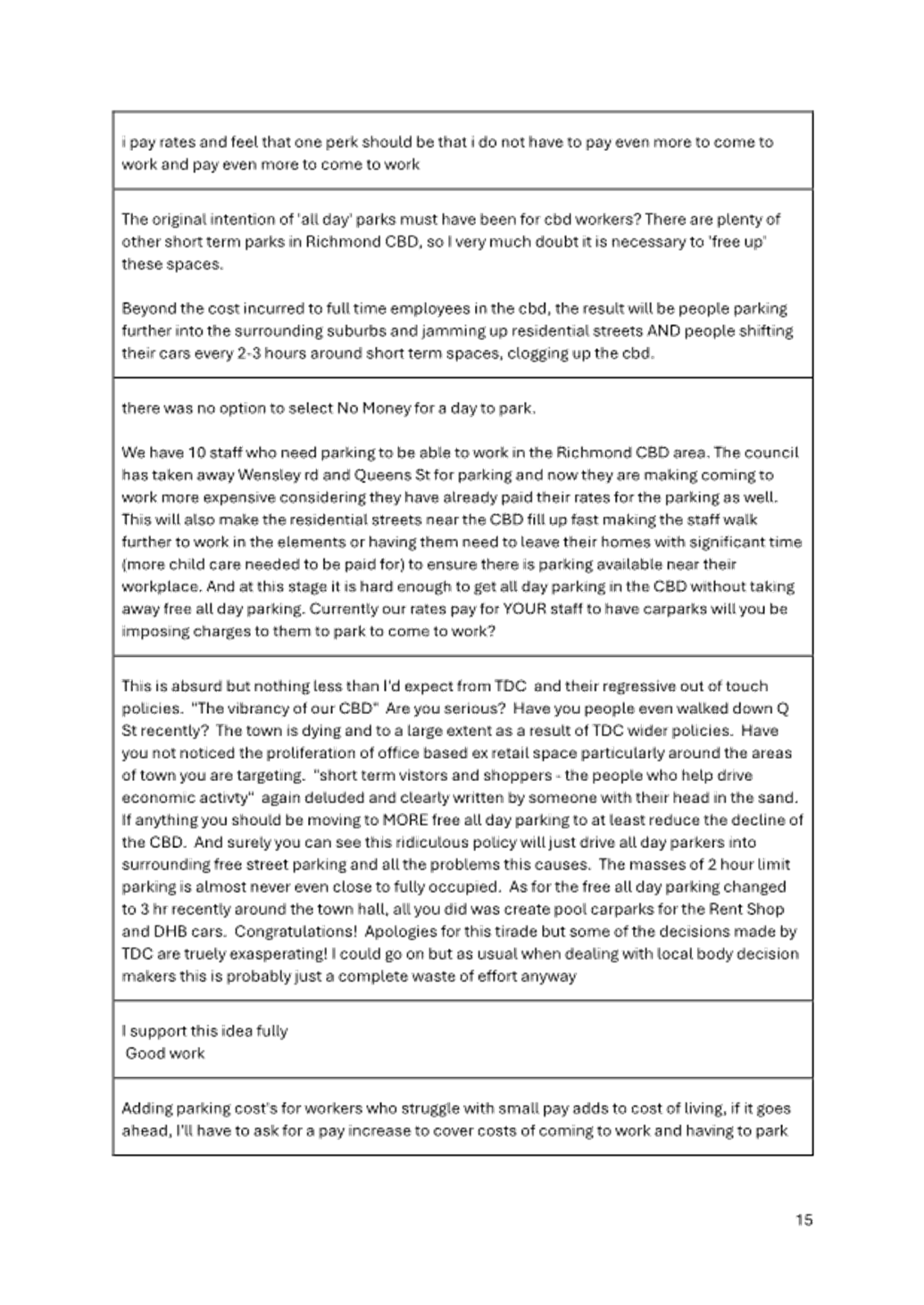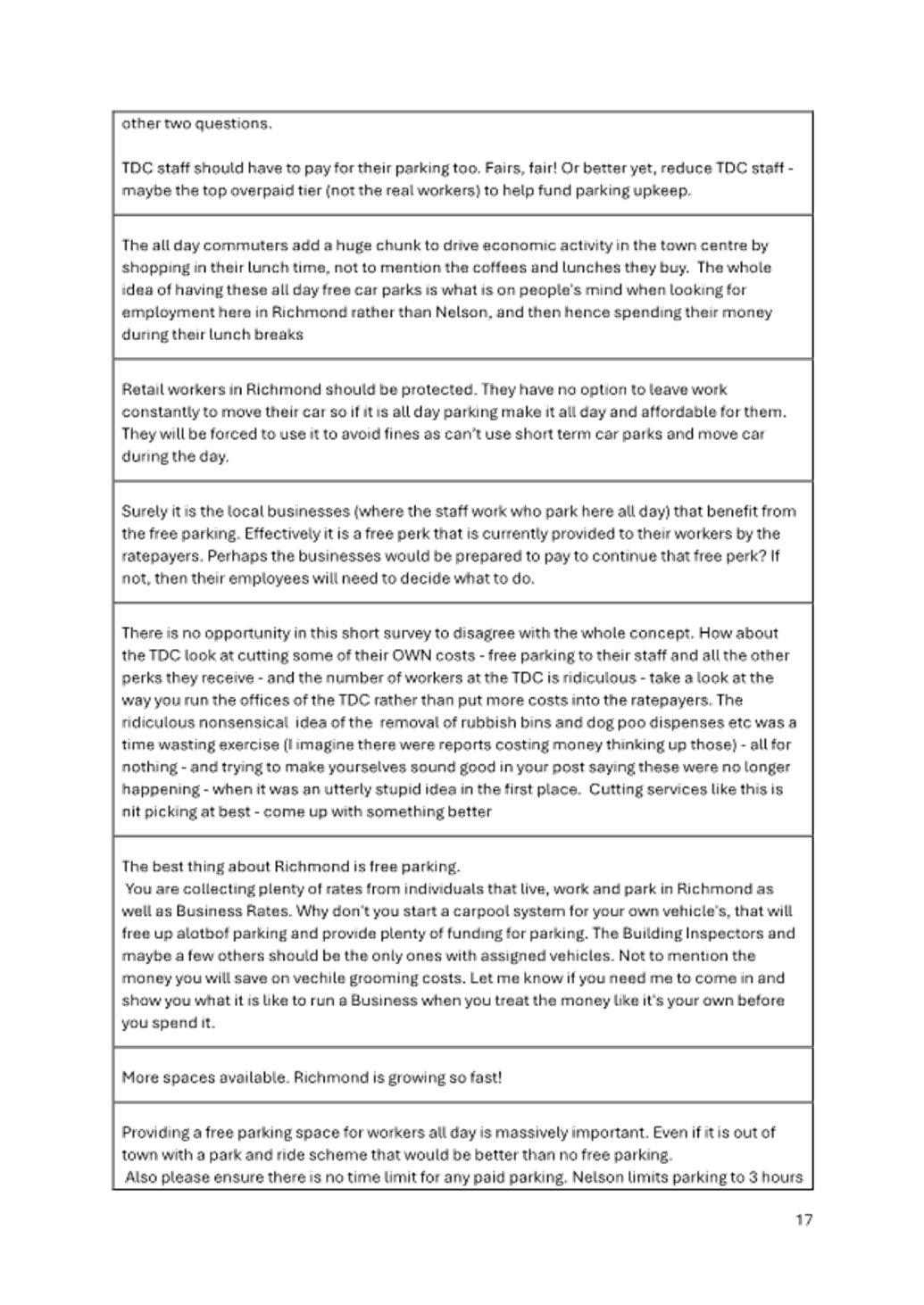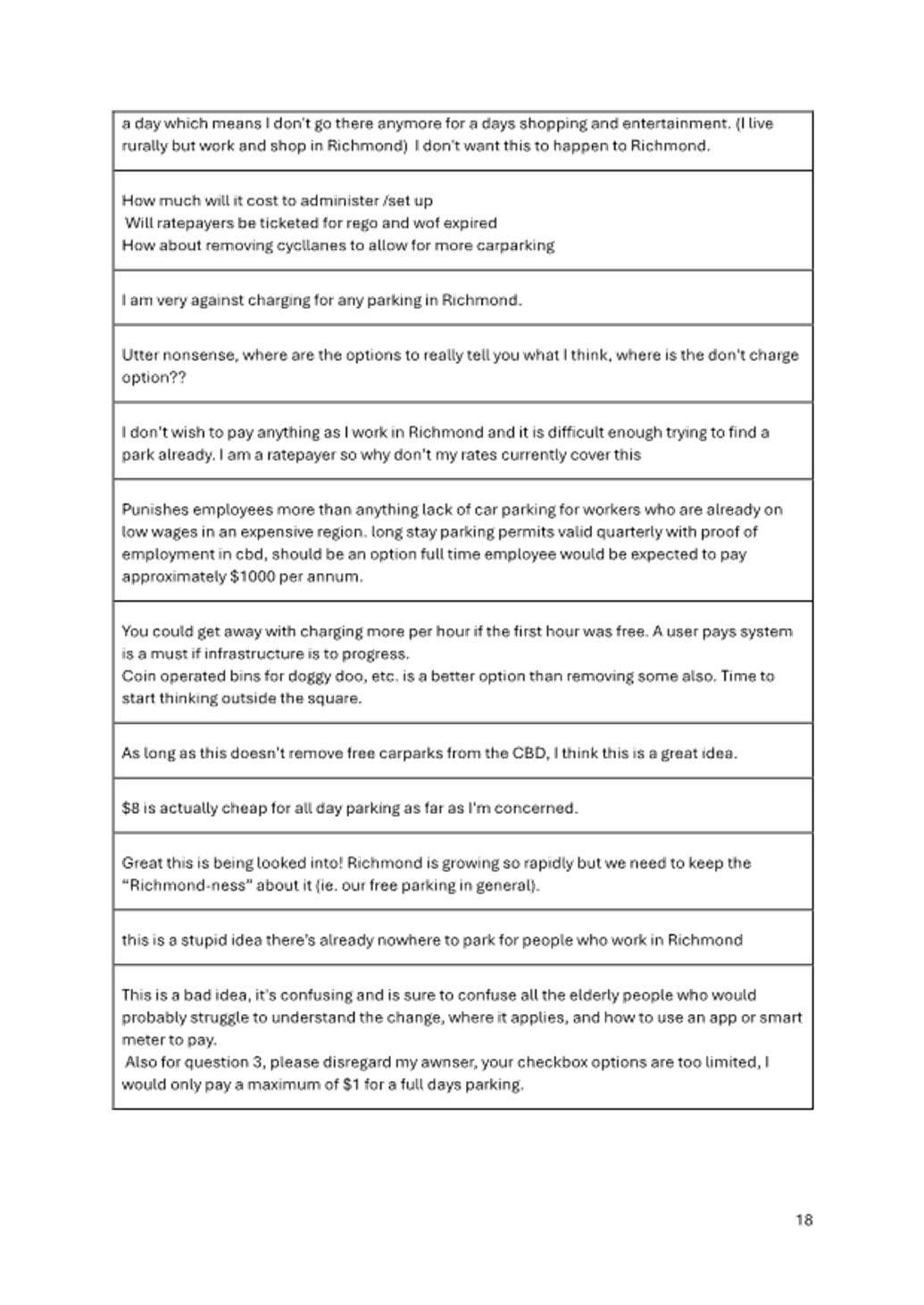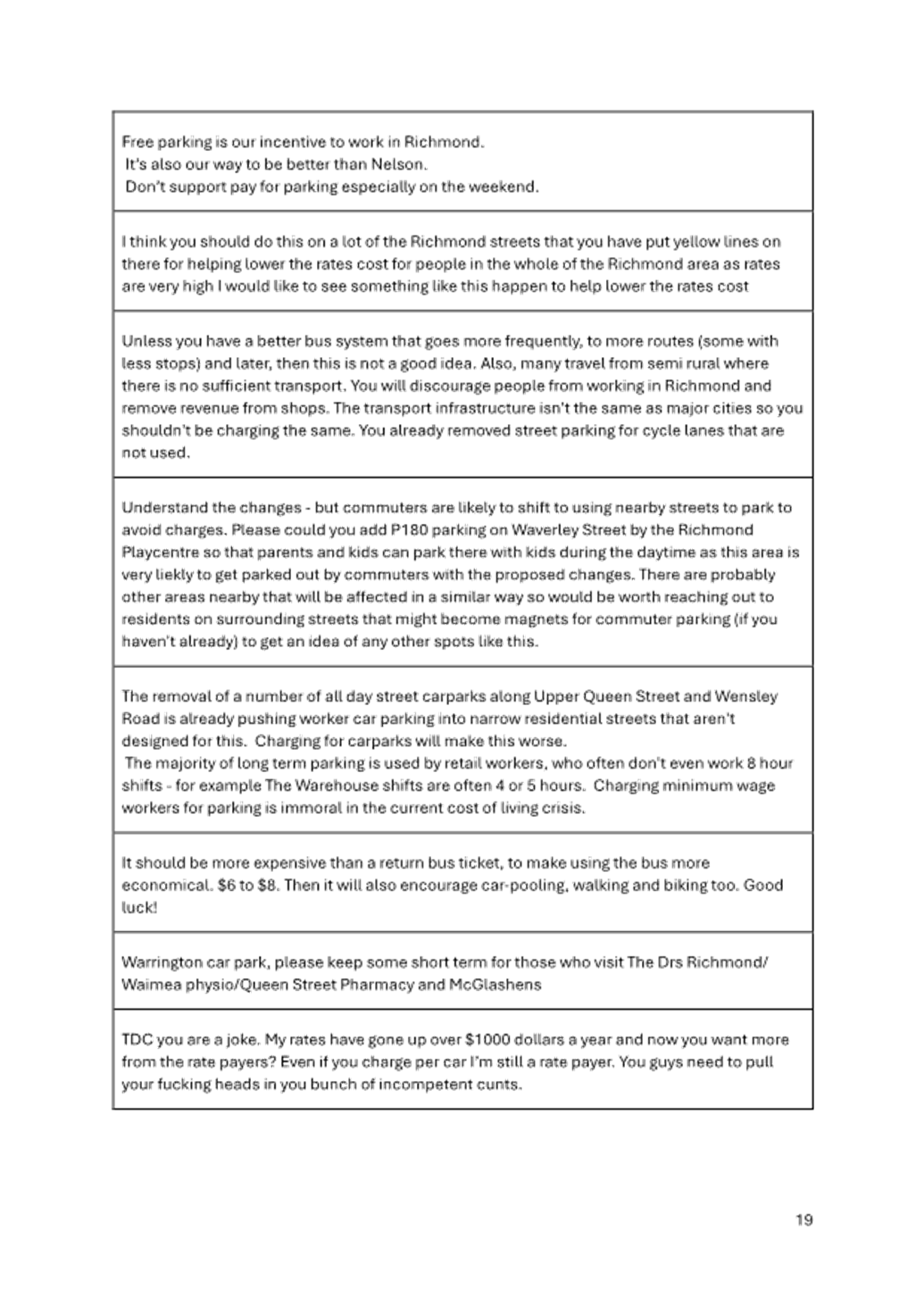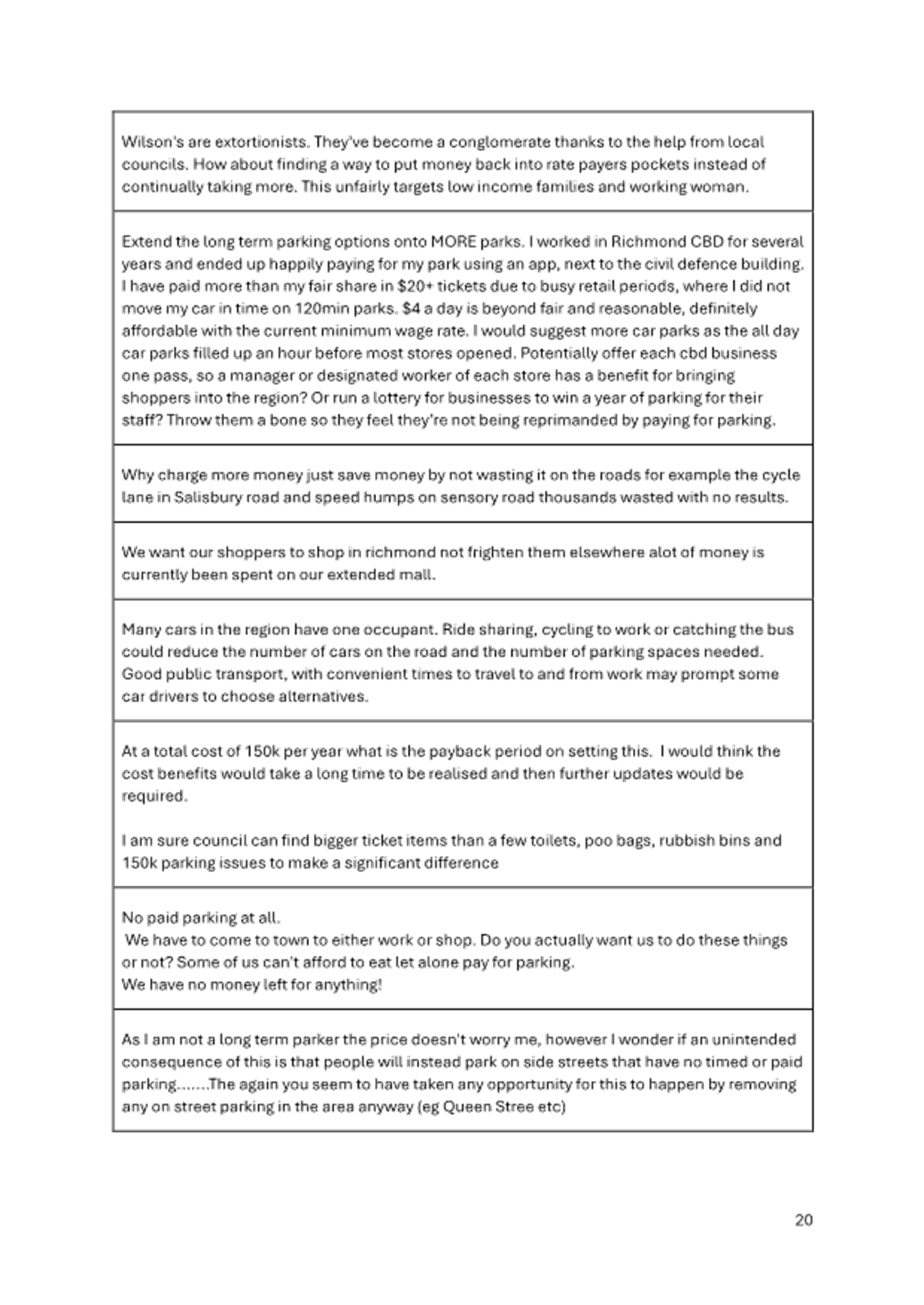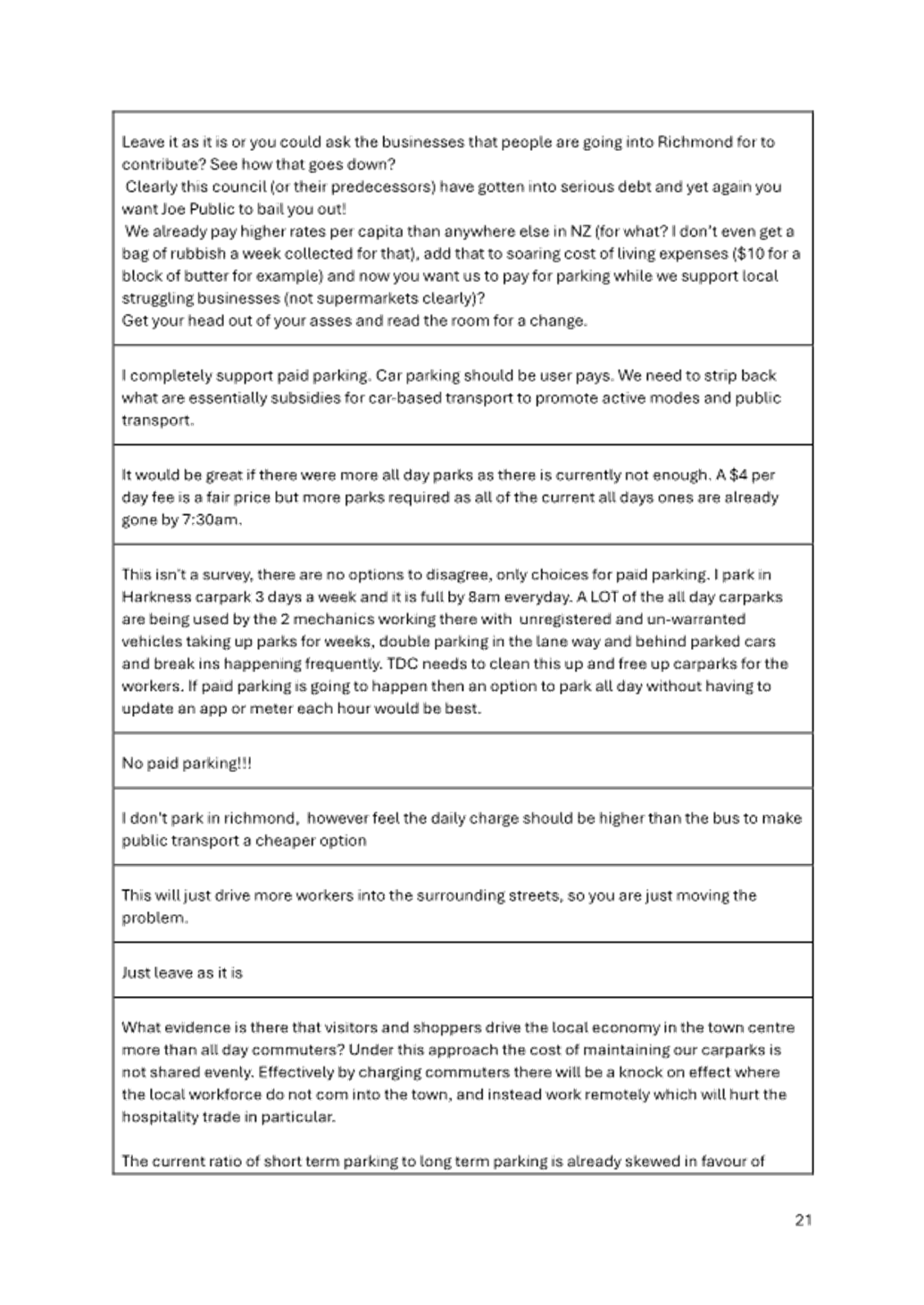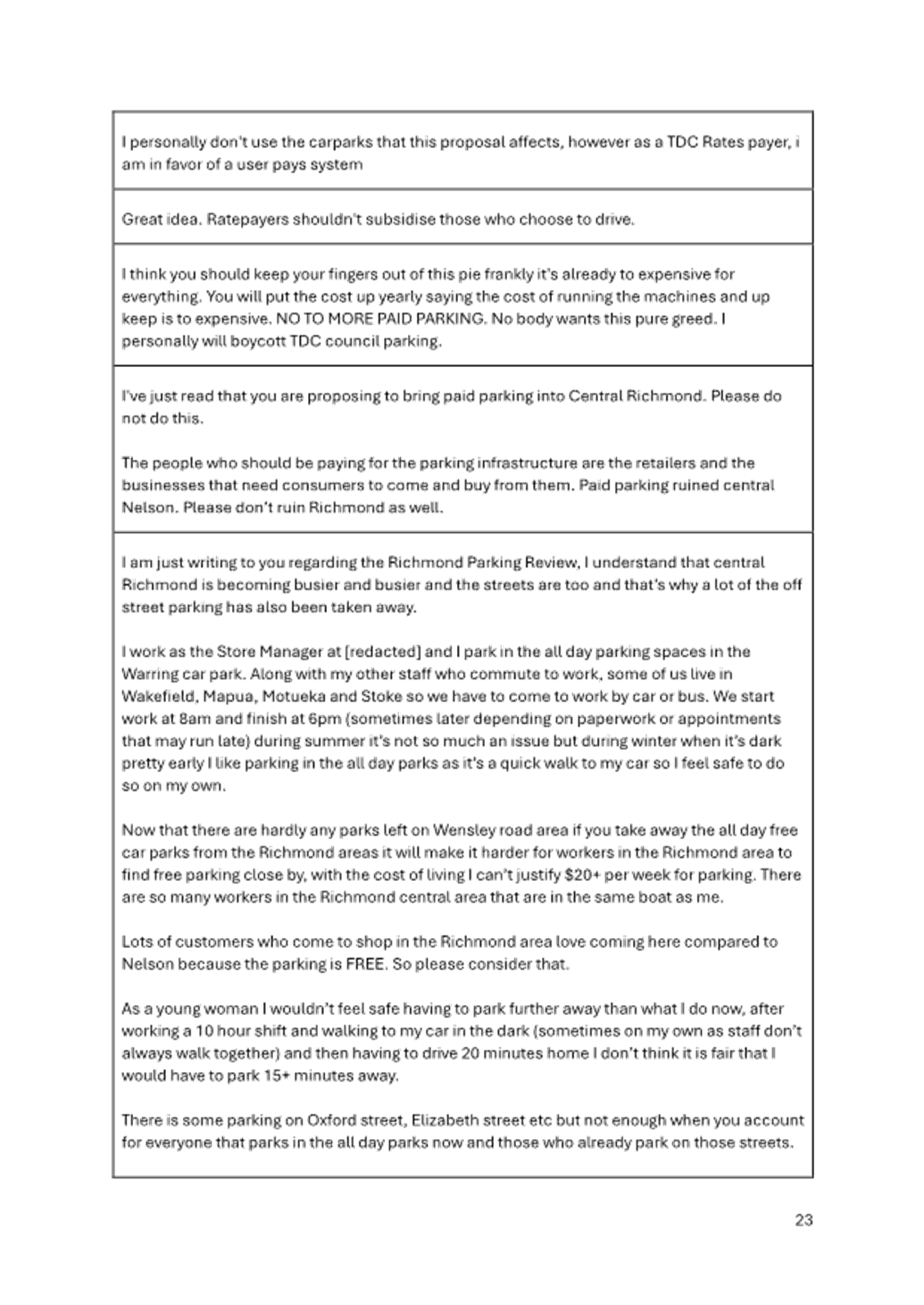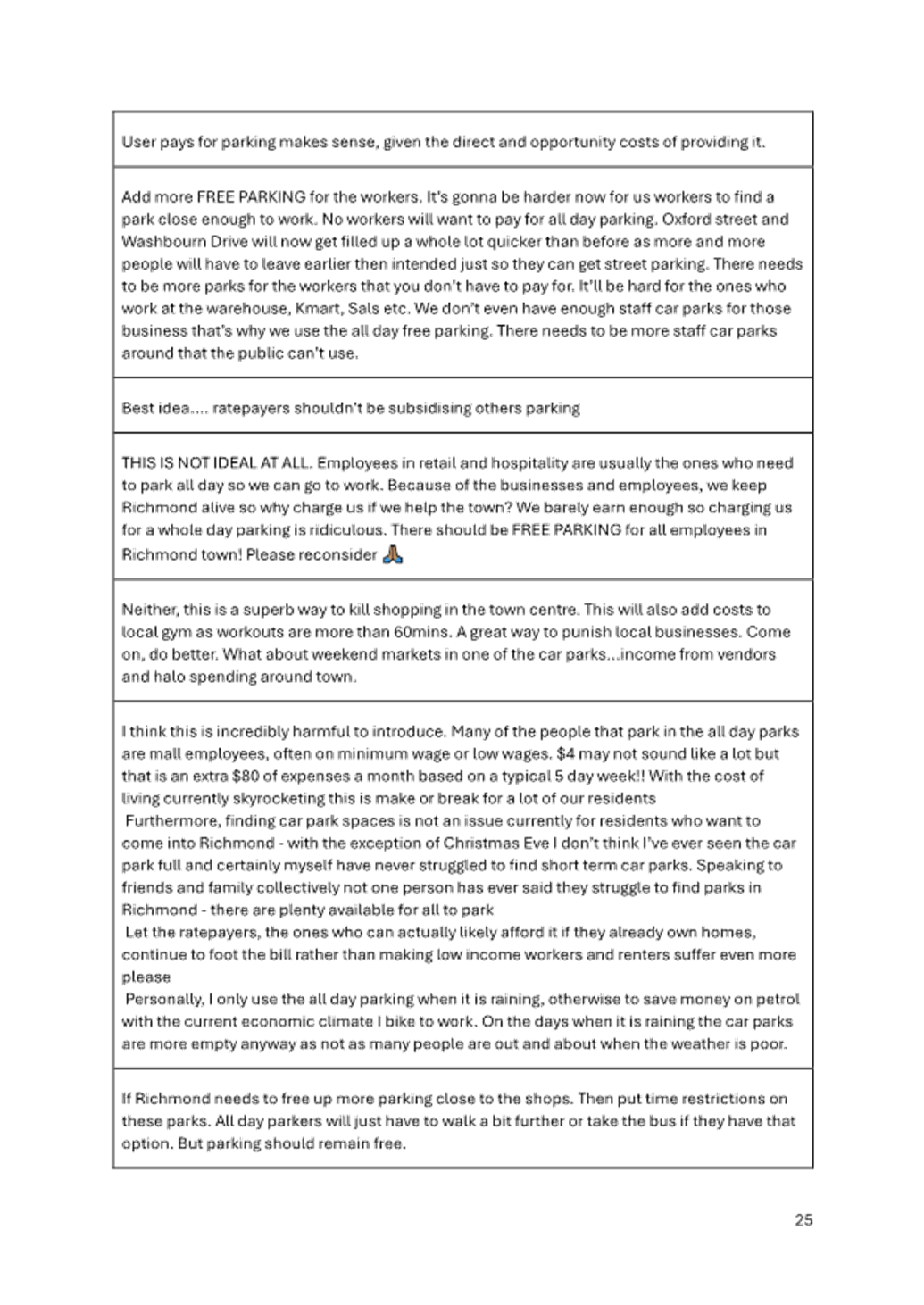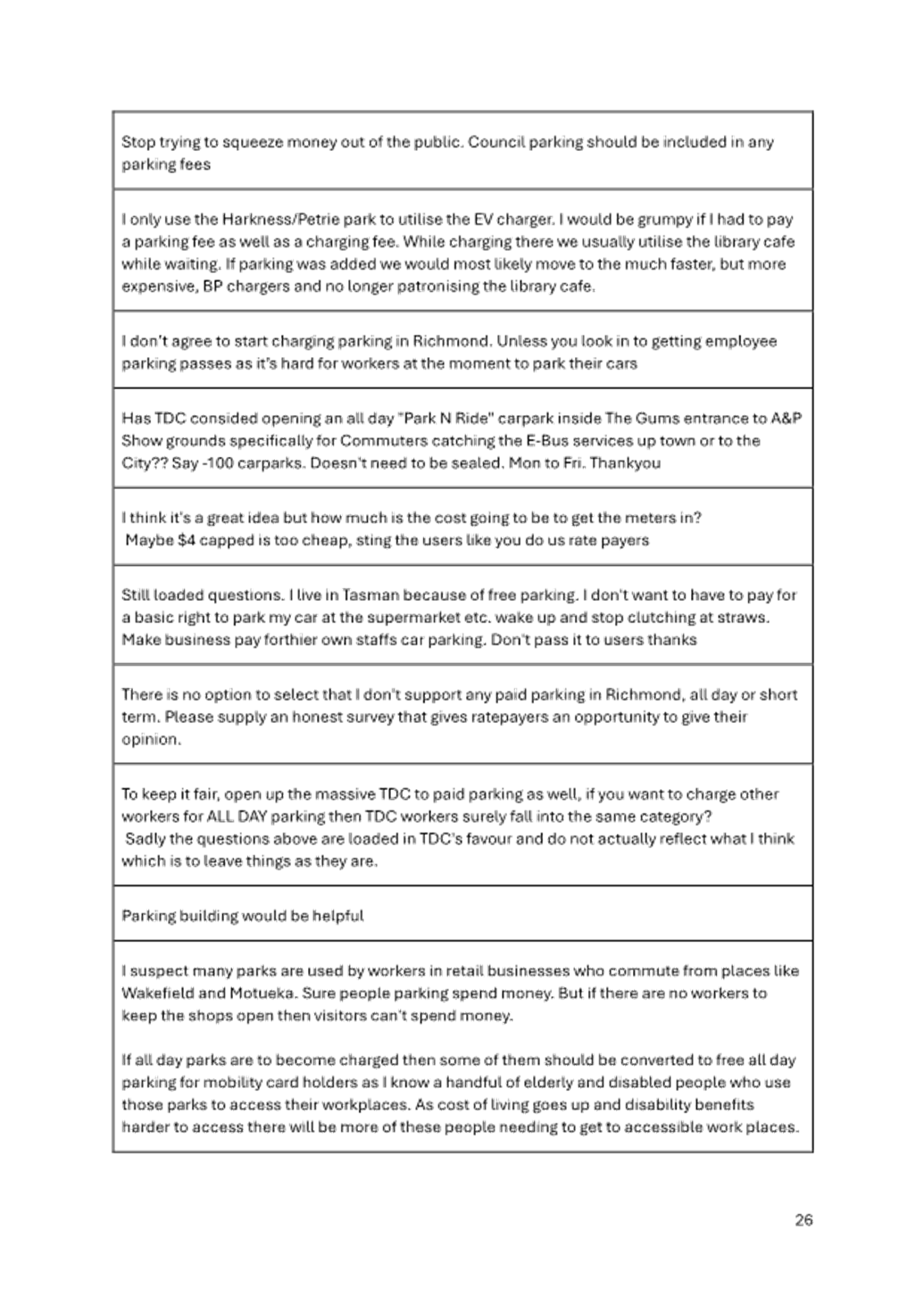Tasman District
Council
Agenda – 04 June 2025
7 Reports
7.1
Annual Plan 2025/2026 -
Deliberations Report
Decision Required
|
Report
To:
|
Tasman
District Council
|
|
Meeting
Date:
|
4
June 2025
|
|
Report
Author:
|
Alan
Bywater, Team Leader - Community Policy; Amy Smith, Community Policy Advisor;
Jane Murray, Transportation Planning Advisor; Michael Goldingham, Team Leader
– Infrastructure Planning; Matthew McGlinchey, Financial Performance
Manager
|
|
Report
Authorisers:
|
Dwayne
Fletcher, Strategic Policy Manager
|
|
Report
Number:
|
RCN25-06-1
|
1. Purpose
of the Report / Te Take mō te Pūrongo
1.1 The
purpose of this report is to:
1.1.1 provide a summary of the submissions
received on the Annual Plan 2025/2026;
1.1.2 provide the Mayor and Councillors with an
opportunity to discuss and obtain advice from staff on the matters raised in
the submissions;
1.1.3 make decisions on matters to be included in
the Annual Plan 2025/2026.
2. Summary
/ Te Tuhinga Whakarāpoto
2.1 At
its meeting on 30 April 2025 the Council made a series of decisions on changes
from the LTP 2024-2034 for 2025/2026.
2.2 The
net outcome of these changes was a rates revenue increase of 8.8% (excluding
growth) for 2025/26, and net debt will be $299m. This was an increase compared
to the 7% planned in the LTP. As a result, Council agrees to consult on the
Annual Plan 25/26.
2.3 At
its meeting on 8 May 2025 the Council adopted a consultation document for a two-week period of
public consultation between 12 and 25 May 2025.
2.4 There were 153 submissions received over
the consultation period, including 31 from organisations and groups. Staff have
prepared an overview of the submissions (Attachment 1) and all
submissions can be accessed and viewed here: TDC
Submissions.
2.5 Several
changes are proposed as a result of submissions or further information becoming
available. However, overall the rates increase has remained at 8.8% as it was
when we went out for consultation. Changes have included;
2.5.1 Resource
Recovery Centre (RCC) adjustment of $310,000 due to a reduction if fees being
charged that will be offset by an increase in the distribution from the NTRLBU
in 2025/2026.
2.5.2 Increase to Keep Motueka
Beautiful funding $5,000 operating.
2.5.3 Decreases assumed revenue from
proposed all day parking charges for 2025/2026 from $100,000 to $40,000 as
meters will only be able to be installed and operational in February 2026.
2.5.4 Add capital expenditure of
$200,000 for a Motueka Heritage Wharf Restoration Project.
2.5.5 Increased capital funding by
$250,000 for the Richmond South (Section H) project in the Water Activity, to
enable 17 hectares of residential land (enough for circa 250 homes) to be zoned
by the end of 2026.
2.5.6 Change of phasing to the
Dovedale water supply capital project. Decrease in capital spend on $1.5m in
2025/26.
2.5.7 Add $1m of capital funding for
land purchases - the Māpua
Master Plan.
2.5.8 Add $25,000 of operating costs
to the Nelson Tasman Chamber of Commerce noting that is offset by a
corresponding decrease in the Nelson Tasman Business Trust (NTBT) due to their
closure.
2.5.9 Increase the Kiwi Saver
contribution from 3.0% to 3.5% from April 1, 2026.
3. Recommendation/s
/ Ngā Tūtohunga
That the Tasman District Council
1. receives
the Annual Plan 2025/2026 - Deliberations Report RCN25-06-1; and
2. notes the submissions made on the Annual Plan
consultation document; and
3. agrees
not to increase funding to the Motueka District Museum; and
4. approves
funding of $5,000 from the Reserve Financial Contributions in 2025/2026 to Keep
Motueka Beautiful for projects on the Council’s reserves; and
5. approves,
provisionally, to increase the capital budget by $1M to allow for a possible
opportunity for a land purchase to aid in the implementation of the Mapuā
Masterplan subject to the upcoming Council decision on this matter; and
6. confirms the water charges for Nelson City Council and
Industrial Users in paragraph 5.57 of the agenda report; and
7. notes
that the water charges for Nelson City Council and Industrial Users will be
incorporated into the Schedule of Fees and Charges 2025/2026 for adoption at
the Council meeting on 25 June 2025; and
8. approves
the allocation of up to $200,000 (depending on the funding shortfall) in
capital expenditure for the Motueka Heritage Wharf Restoration
Project in the 2025/2026 financial year; and
9. approves funding of $25,000 per annum plus adjustment for inflation
from 1 July 2025 to 30 June 2027 to the Nelson Tasman Chamber of Commerce to
provide business support and mentoring services to Tasman businesses; and
10. approves
the increase in capital budget for Richmond South (Section H) water supply
project by $250,000; and
11. approves
the decrease (deferring) in capital budget for the Dovedale water supply new
source and raw water pipeline from $1.97M to $0.5M for the 2025/26 Annual Plan;
and
12. notes
the increase to the employer Kiwi Saver contribution from 3.0% to 3.5% from
April 1, 2026; and
13. confirms
the introduction of paid parking for all day parking on off-street carparks in
Richmond at the tariff’s proposed in consultation, but with a delayed
start date of February 2026; and
14. agrees
to decrease the assumed revenue from paid parking from $100,000 to $40,000 for
2025/2026; and
15. approves the use
of reserves to fund the $310,000 shortfall in the Waste Management &
Minimisation area with this being recouped in the 2026/2027 year from an
increase to the Nelson Tasman Regional Landfill Business Unit distribution; and
16. notes
that the Annual Plan 2025/2026 will be presented for adoption at the Tasman
District Council meeting on 25 June 2025.
4.1 There
are a range of cost pressures that are increasing our costs for 2025/2026
compared with those in the LTP 2024-2034. The primary drivers of these
increased costs are:
4.1.1 higher than anticipated
interest rates.
4.1.2 higher depreciation
funding (as a result of increased asset valuations).
4.1.3 higher electricity costs.
4.1.4 higher maintenance costs.
4.1.5 new costs involved in
water supply regulation from Central Government.
4.1.6 numerous other smaller
increases.
4.2 In
addition, expenditure forecasts for the 2024/2025 year indicate that the
Council will have a net operating deficit greater than planned. Staff have been
implementing measures to reduce expenditure, but it is highly likely that a
deficit of approximately $6.5m will still be recorded. This affects the
financial starting position going into the 2025/2026 Annual Plan year.
4.3 To
try to limit the impact of the increasing costs on the rates increase for the
2025/2026 year the Council has:
4.3.1 Proposed increasing
most fees and charges by 10%.
4.3.2 Indicated an
interest in selling $3.0m of unencumbered Emissions Trading Scheme (ETS)
credits to offset the forecast $6.5m overspend in the 2024/2025 financial year.
4.3.3 Carried out a
business review process to identify other opportunities to reduce costs and/or
increase revenue across the Council.
4.4 Staff
presented opportunities from the business review process and sought elected
member feedback at a series of workshops.
4.5 At
its meeting on 30 April 2025 the Council made a series of decisions on changes
from the LTP 2024-2034 for inclusion in the Annual Plan for consultation.
4.6 At
its meeting on 8 May 2025 the Council adopted a consultation document for a two
week period of public consultation between 12 and 25 May 2025.
4.7 At its
meeting to deliberate on the Schedule of Fees and Charges on 27 May 2025 the
Council decided to reduce the proposed increase to mixed refuse fees from 18%
to 15% which requires an increase in rates revenue of 0.215% over and above the
8.8% rates revenue increase included in the Annual Plan consultation
document.
5. Analysis
and Advice / Tātaritanga me ngā tohutohu
5.1 There were 153 submissions received over
the consultation period and we have prepared an overview of the submissions (Attachment
1). All submissions can be accessed and viewed here: TDC
Submissions.
5.2 The community were invited to
indicate whether they supported the Council’s approach to achieving the
proposed rates revenue of 8.8% for 2025/2026 and provide feedback on the 15
proposals presented in the consultation document.
5.3 66 submitters did not support the
Council’s approach to the rates revenue increase, 14 submitters supported
the approach and 13 submissions were unclear.
5.4 The submission feedback regarding the
proposals in the consultation document has been summarised below.
Catchment Management
5.5 Seven submissions were
received on the proposed reduction to the Catchment Management Fund. They
all highlighted the importance of this fund noting variously the role. Tasman
waterways play as a tourist attraction, water quality, ecological health of
water bodies and meeting the objectives of NPS -FM.
5.6 While
staff believe that the Catchment fund is important to get increased
environmental gains and leverage best practice from our landowners. This budget
reduction is part of the cross-Council cost reductions to moderate the impact
on rates. One consequence of dropping this funding is that we will not be
able to leverage additional gains from the Jobs for Nature funding programmes
as they start to wrap up at the end of this financial year. Staff will be
bringing back requests to increase this funding as part of the next LTP process
as we leverage off the back of the Farm Planning exercise and as we move to
secure the gains made following the significant spend following the Jobs of
Nature, Freshwater Improvement, and Billion Trees funding projects.
Information Technology
5.7 Two
submissions were received on information technology with neither being
supportive of the Council’s investment in this area.
Engagement and Communication
5.8 Only
one submission was received on this topic with the submitter considering the
Council spends too much on this activity.
Community Funding
5.9 Five
submitters advocated for not reducing the funding for school pools and
community events. They highlighted the impact this will have on opportunities
for families to engage with others and the (perceived) lack of priority and
inadequate funding provided by the Council for these activities, which they
consider have substantial benefits.
5.10 With regards to
events, there has been a purposeful move away from providing a wide range of
events and focus on quality events that attract a large cross section of the
community. The team who delivers the events is small with a wide focus
beyond events such as environmental education. The budget allows
flexibility to alter which events are supported annually, but within the
financial envelope. Officers’ advice has not changed in
recommending the reduction of the events budget.
5.11 The
school swimming pool subsidy is a long-standing budget to assist with the cost
of opening school pools during the summer, to encourage safety around
water. The budget and the actual allocations have tracked differently
over several years. The proposed reduction lines up with actual
applications and allocations to date. To this end officers continue to
recommend a reduction in the budget.
Roading and Public Transport
5.12 Three
submitters commented on the correction of a budget error for Māpua Ferry
with two reinforcing the importance of this service for Tasman’s Great
Taste Trail and the other indicating it is a luxury. The Nelson Tasman Cycle
Trail Trust urged the Council to continue with its investment in Tasman’s
Great Taste Trail. One submitter suggested reducing the frequency of
ferry services in the off-peak season.
5.13 Staff
note that the Māpua Ferry is an important link in Tasman's Great Taste
Trail. Without this link, the government funding we receive for operating and
maintaining the Trail would be at risk. The currently contracted services have
been determined as a balance between needs of cycle trail users, and costs.
5.14 Six
submitters expressed proposed reduction in footpath and cycle maintenance
budgets, noting variously the impacts on greenhouse gas emissions and pollution, safety, children and
youth, elderly people and people on mobility scooters.
5.15 Staff
note that these budget reductions are the result of New Zealand Transport
Agency (NZTA) funding reductions for these modes of transport. The
Council previously considered but decided not to increase local share of
maintenance costs to replace the reduced NZTA funding in 2024 to 2027.
Paid Parking Richmond
5.16 Paid
parking was one of the identified interventions in the 2018 Richmond and
Motueka Town Centre Strategy for managing parking demands and getting best
value for money. As part of the Annual Plan public consultation, a two-week
survey was conducted where we received 347 responses on paid parking.
5.16.1 60%
of respondents thought that parking users should cover the cost of carpark
maintenance (n=206) compared with 40% of respondents who thought rate payers
should cover the cost of carpark maintenance (n=137).
5.16.2 58%
of respondents (n= 183) stated they would prefer to have both parking meters
and a smartphone app. 22% stated that they would prefer to use parking meters
(n= 68), 20% stated that they would prefer to use a smartphone app (n= 62).
5.16.3 When
asked, how much people would be prepared to pay for parking, the majority said
$4 a day was the maximum [67% (n= 207)], a minority were prepared to pay
more: a) $5 a day [5% (n= 48)], b) $6 a day [9% (n= 29)], c) $8 a day [8% (n=
26].
Attachment 2
provides more detail on the Shape Tasman feedback on paid parking.
5.17 The
key themes of the survey from the 160 comments were received are as follows:
5.17.1 Did
not agree with paying for all-day car parks (52%, n=83)
5.17.2 $4
a day is difficult for employees (18%, n=28)
5.17.3 Agree
with all day car parking (15%, n=25)
5.17.4 Free
parking makes Richmond attractive (15%, n=24)
5.17.5 Will
create a problem on residential streets: (15%, n=24)
5.18 Paid
parking is a divisive topic and there will always be a range of differing
views. The pricing of our proposed paid parking [$1 an hour up to a maximum of
$4, first hour free] is low in comparison to other South Island regional
centres including Nelson which charges $2 an hour. Should people choose not to
pay, then the roads around the town centre provide free parking options within
a 10-minute walking radius. We currently monitor parking demand at a 5-minute
walking radius from the CBD. Provision of a small number of time-restricted
parking locations within residential streets may be required to ensure these
streets have some visitor parking available.
5.19 Staff
recommend confirming the introduction of paid parking for all-day off-street
carparks in the Richmond town centre at the tariff’s proposed in
consultation.
5.20 However,
staff have been investigating the implementation of paid parking and do not
consider that we can hit the October 2025 timeline proposed. Instead, February
2026 is proposed. Forecast revenue will be lower as a result and the Annual
Plan will need to reflect this. Staff estimate net revenue for the 2025/2026
year will be $40,000 rather than the $100,000 proposed. Net revenue in
following years is still expected to be circa $100,000 per annum.
Urban Stormwater Networks
5.21 In
its submission, Forest and Bird urged caution regarding reducing the budget for
routine maintenance for vegetation control in open channels.
5.22 Staff
note that the budget reduction will mean a lower level of service in vegetation
control and may result in more untidy sites with ling grass etc. However,
we still intend to protect riparian zones with appropriate planting and
vegetation control.
Library Services
5.23 105
submitters strongly opposed the proposed reductions in library budgets and the
consequential impact on services. There was no support for this proposal
in submissions. Submitters referenced high level of library usage by a wide
range of different age groups with the impact of the proposed reductions on
children particularly highlighted. They reinforced the role of libraries
as community hubs enabling the community interaction, providing a sense of
place and enhancing vibrancy. Several submitters commented that the
impacts are large for a relatively small budget saving and on the apparent
contradiction in investing in a new library in Motueka and then reducing its
opening hours.
5.24 The Annual Plan
consultation document has signalled a proposal to reduce District Library
funding by $130,000. This proposed change funding provision will result
in the reduction of staffing levels by removing two vacant full time positions
in Motueka and Richmond. In order to cover customer service desk
activities, particularly cover for holidays and sickness and established
programmes it will require an adjustment of service levels. This is as
outlined within the background information provided at workshops.
5.25 The
District Library budgets have been adjusted over a number of years. It
would not be possible to find alternative budget reductions within the District
Libraries, without any effect on services, if there was a decision to retain
this funding within the annual plan 2025/2026.
Operating and Maintaining Council’s Water Supplies
5.26 Three submissions commented on our
proposals for budget changes for water supplies. Staff note that we
proposed a decrease of $140,000 for condition assessments of our water network
and modelling. We have an increased renewal budgets ($750,000) to replace
aging pipes before they fail too often and improving resilience.
Emergency Management
5.27 Three
submissions were received on emergency management. One of these
criticised the involvement of iwi, one suggested recovering the costs of
managing oil spills from the parties responsible for the spills and one
supported the budget increase.
5.28 Staff
note that iwi representatives are a critical part of our CDEM service.
Iwi/Māori are one of our partners and have systems and processes in place
that make the CDEM response and recovery phase much more effective.
5.29 In
response to the submission on oil spill management, staff agree that where
possible we need to recover costs. In this case, the cost is to set the service
up and actually allows Council an appropriate and fully staffed response
capability.
Iwi Partnerships
5.30 Three
submissions supported the budget increase for iwi partnerships. One
submission recommended removing the Māori ward and iwi partnership costs
and one submission requested more details on this budget.
5.31 Staff
note the increase in iwi partnership budgets is minor and is consistent with
continuing to develop the partnership between Iwi and the Council.
Regulatory Services
5.32 Four
submitters supported the increased budget for regulatory services with the
Tasman Bay Blue Penguin Trust supporting the increased level of service for Dog
Control in particular.
5.33 Four
submitters questioned the value of bringing regulatory services in-house at
increased cost.
5.34 Dog
Owners Golden Bay critiqued various aspects of the Council’s dog control
work and the process to develop the Dog Control Bylaw 2024.
5.35 The decision to
bring the rest of the Regulatory Services associated with these functions
in-house was triggered by the former contract price not being financially
sustainable for the operator. A formal Section 17A review was conducted
in March 20245 which assessed the delivery model for these regulatory
services. The conclusion was that an in-house model would, over the medium to
long term, offer improved value for money, stronger service delivery, and
greater alignment with Council’s strategic objectives and community
expectations.
5.36 While
one of the drivers of this change was to better manage costs, the 2025/2026
budget reflects transitional and start-up costs associated with establishing
in-house capability. These include recruitment and training of new staff,
investment in systems, equipment, and infrastructure, the need to maintain
continuity of service during the transition.
5.37 The
increased cost is also linked to the increased scope of the new Dog Control
Bylaw and the new emphasis of national direction feeding into the upcoming
freedom camping bylaw.
Wastewater Schemes
5.38 In
its submission Forest and Bird supported the increased budget for routine
wastewater maintenance and the increased funding for the Nelson Regional
Sewerage Business Unit (NRSBU) to reduce wastewater overflows. It
however, strongly opposed the decrease in the reactive maintenance, inflow and
infiltration (I&I) reduction programmes, and CCTV inspections. Forest and
Bird considers that reducing efforts to proactively identify and repair leaks
and reduce I&I is counterproductive to reducing overflows and will likely
lead to ongoing environmental contamination, breaching NPS-FM requirements.
5.39 Staff
agree that it is important to monitor the networks and reduce I&I to reduce
the risk to public health and the environment from wastewater overflows. Recent
rain events have again highlighted the importance of identifying and fixing I
&I issues even in relatively new subdivisions there is significant impact
from inflow causing overflows or increased cost during events to manage the
flows. The budget reduction was proposed to help reduce the rates revenue
impacts on Tasman ratepayers, noting that wastewater budgets overall are
proposed to increase in 2025/2026.
Maintaining our Parks and Reserves
5.40 Only
two submissions were received on this topic, with Forest and Bird supporting
the increase in budgets and the Motueka Community Swimming Pool Committee
expressing its appreciation for the budget being brought forward.
Other Matters Raised in Submissions
5.41 Tasman Democracy raised concerns about the process
and information provided to the public as part of the consultation. Council
considers that it has met the requirements of the Local Government Act 2002 in
respect to its consultation on the Annual Plan.
5.42 Staff
note advice from the Motueka District Museum Board of their additional cost
pressures that are making it harder to continue to operate. The key increases
are related to insurance, power, maintenance, and staff wages.
5.43 It
is recognised that ongoing significant funding pressure does make it harder for
entities such as the Motueka Museum to continue to provide the same level of
service. However in light of similar costs increases facing and the level of
rates revenue increase already proposed, staff do not support this request.
5.44 It
is also noted that providing increased funds to one entity could set a
precedent whereby other organisation would seek similar increases which Council
would not be able to meet without impacting rates.
5.45 Wakatū
Incorporation noted its disappointment with the size of rates rises for
householders in Motueka and advocated for the Council to concentrate on core
Council functions when making funding decisions. Wakatū suggested a
review of some compliance practices to ensure that they align with legislation
citing soil contamination management as an example. It advocated for
consultation on compliance practices and consideration about how they apply in
the local context. Wakatū also noted tight resource consent conditions
for Council projects, which often require multiple variations and results in
further costs.
5.46 In response to
Wakatū Incorporation’s comments on compliance practices, staff
consider that current compliance practice does align with current legislation
and supporting national instruments. The requirement of the National
Environmental Standard for Assessing and Managing Contaminants in soils to
Protect Human Health Regulations (NESCS) have not changed. Surplus contaminated
soils which are being moved from a HAIL site must be taken to an authorised
facility. Regional background soils values are used to help identify where
soils can be disposed of and the current approach to determining clean fill has
been based on a report from 2015 which used a combination of background
concentrations and ecological soil guideline values
5.47 Staff agree
that our District needs a better framework for dealing with class 4 and 5
materials from contaminated sites. Council is progressing a plan change to
provide better management of class 4 and 5 materials. A draft policy framework
was discussed with a section of contractors and contaminated site specialists
recently with the aim of getting a plan change out for consultation in the next
few months.
5.48 In
response to Wakatū Incorporation’s critique of resource consent
conditions, staff note that consenting is a balancing act
between defining detail up front and flexibility during the construction /
build process. Applicants are able to propose a set of conditions that
appropriately regulate their activity, but it is too often the case that the
conditions need to be developed by the consent planner. Further, conditions can
be reviewed before a consent is issued. We agree that positive outcomes for the
community and the environment are important but also acknowledge that it is
difficult to develop a set of conditions that achieve a balance that suits all
interests.
5.49 Keep
Motueka Beautiful is seeking funding of $5,000 in 2025/2026 to enable the
upgrade and extension of a footpath in Sanctuary Ponds and carry out weed
control.
5.50 Staff
recommend support this submission, noting the valuable work Keep Motueka
carries out in the community. This funding should only be used for work
in Council reserves in close liaison with the Council’s Reserves and
Facilities staff. This $5,000 additional funding would be funded from
Reserve Financial Contributions.
5.51 The
Heritage Wharf Restoration Group is seeking funding of between $25,000 to
$200,000 to assist in the renovation of the Motueka Heritage Wharf, which is a
Council asset. The actual level of funding the group requires will depend
on whether or not it is successful with a Lotteries funding application.
5.52 Staff confirm
that professional advice obtained in late 2023 concludes the heritage wharf is
owned by Council; the 2024 Coastal Assets AMPs acknowledges this ownership but
notes that ongoing management of the wharf had not been accounted for as it is
not an “operational” structure.
5.53 Staff
have been supporting the Heritage Wharf Restoration Group for several years to
date, contributing time, advice, and project management support. Staff have
also administered the $10,000 budget approved by the Motueka Community Board in
2024 to procure structural engineering services to support the project.
5.54 The
Heritage Wharf Restoration Group have been very successful in securing funds
and enabling Archaeological Authority on behalf of TDC to complete the
restoration work; the only remaining barrier to completing the work is
sufficient budget to top-up the growing pot of grants the Group has already
secured. The hard work of the Restoration Group presents a unique opportunity
for Council to complete the restoration work in an efficient, timely, and
cost-effective way.
5.55 Staff
recommend providing funding up to $200,000 depending on the outcome of the
Lotteries funding application. As this funding is being applied to a
Council asset it is capital expenditure and should be funded by borrowing with
a minor impact on rates revenue of $20,000 to service the loan. The work on the
Heritage Wharf will be managed by the Project Delivery Office.
Water Charges for Nelson City Council and Industrial
Users
5.56 The
water charges for the service supplied to Nelson City Council and the Nelson
Industrial Water Supply area are calculated based on rates information so that
these charges change in line with the rates.
5.57 At the 30 April 2025 meeting the Council
approved the proposed charges for the water supplied to Nelson City Council for
the Nelson residential water supply area and supplied to the Nelson Industrial
Water Supply Area below.
|
Water Supply
|
Proposed Charges from 1 July
2025 incl. GST
|
Current
Charges Incl. GST
|
|
Water supplied by Tasman District Council to Nelson
City Council (Nelson Residential Water Supply Area) per cubic metre supplied
|
$6.79
|
$6.12
|
|
Water supplied to Nelson Industrial Water Supply Area
(per cubic metre supplied)
Plus fixed daily charge per rating unit
|
$4.08
$1.90
|
$3.56
$1.80
|
5.58 These charges affect a defined group of
organisations being Nelson City Council and the industrial water users.
Staff contacted these groups to carry out targeted consultation with them.
5.59 No
feedback has been received from these organisations and staff recommend
confirming the proposed fees listed above.
Nelson Tasman Business Trust (NTBT) – Nelson Tasman
Chamber of Commerce (the Chamber)
5.60 Council
has a three-year funding agreement ($25,000 plus inflation per annum) with the
NTBT approved through the LTP 2024-2034, to provide business support to
businesses in Tasman. Due to closure of the NTBT as from 30 June 2025.
5.61 The
Nelson Tasman Chamber of Commerce has advised it is able to provide these
services.
5.62 The
Council has a positive relationship with the Chamber and it has a strong
profile across Tasman businesses already.
5.63 Therefore
Council staff consider the Chamber as being well positioned to provide these
services and recommends the remaining two years of the approved LTP funding be
provided to the Chamber to carry out business Mentoring and Support across
Tasman in agreement with a confirmed Funding Agreement.
Additional
Capital Budget Changes
5.64 Staff have identified three additional changes to
the capital expenditure budget that overall supports the reduction of the
identified deficit and also supports growth.
5.65 The first is to increase the capital budget by
$250,000 in 2025/2026 (budget brought forward) to support the upzoning of 17Ha
of deferred land in Richmond South to allow growth to occur in the area in a
timely manner (equivalent of approx. 250 properties). Being a growth project
this will be funded by Development Contributions. It is to take the opportunity
(of efficiencies) to install a falling main (for local reticulation) at the
same time as the current project to install the main trunk pipe to the reservoir
(also currently getting constructed). This cost will be included in future
development contribution charges when the policy is next updated in 2027.
5.66 The second is to decrease the 2025/2026 budget for
finding and installing a new source of water for Dovedale from $1.97M to $0.5M.
This resultant budget (~$1.5M) is to be deferred over the following two years.
The overall budget is $6.3M spread over 4 years which is not expected to
change. Completion time of the project will not be affected. The reallocation
is due to the rephasing of the project that allows for design and consenting to
happen next year, prior to construction in following years.
5.67 The third change is to provisionally increase the
capital stormwater budget by $1M. The budget is to possibly purchase a section
of land that could be utilised for stormwater detention and/or wetland in the
Seaton Valley area. This is to support the implementation of the Mapuā
Masterplan following the masterplan process. This is provisional on the basis
that a decision on whether to recommend this land purchase from the Māpua
Masterplan Hearing Committee is expected on 5 June 2025. The cost, if
required, will be recovered 80% through development contributions. This cost
will be included in future development contribution charges when the policy is
next updated in 2027.
Additional Employer Kiwi Saver
contribution
5.68 In the recent budget announcement by Central
Government an increase in the employer contribution was mandated, From 1 April
2026 the contribution will increase from 3.0% to 3.5%. The impact on TDC is
$70,000.
Waste Management and Minimisation
5.69 At the Council meeting on the 27th
of May Council agreed to the reduction to the fees and charges associated with
the disposal of waste at the TDC resource recovery facilities. Council also
made it clear that they would expect the rate increase associated with this to
be neutral.
5.70 To give this effect staff will request an
increase to the NTRLBU distribution by the $310,000 in the 2026/2027 financial
year. If successful, this will mitigate the impact of the reduction if fees.
Motueka Community Board
5.71 The Motueka Community Board wanted no
increase to the Motueka Community Board rate in 2025/2026, as well as
commenting on other aspects of the Community Board’s budget.
5.72 Staff can confirm that there has been no
increase to that targeted rate. In due course staff will discuss the budget
aspects of the submission with the Community Board and ensure that the budget
reflects their wishes. Any change will be immaterial and will not impact the
Motueka Community Board rate.
6. Financial
or Budgetary Implications / Ngā Ritenga ā-Pūtea
6.1 The net outcome of the changes
decided on in the Annual Plan 2025/2026 resulted in a rates revenue increase of
8.8% (excluding growth) for 2025/2026, and forecast net debt of $299m.
6.2 Through the LTP 2024-2034 and the budget
reductions included in the Annual Plan consultation document we have very
limited capacity to respond to shocks. We have exhausted our ability to
absorb any increases in operational costs through the deliberations process
without this being reflected in further rates revenue increases.
6.3 At the deliberations meeting for
the Schedule of Fees and Charges on 27 May 2025 the Council decided to reduce
mixed refuse fees by 15% instead of the proposed 18% with a resulting increase
in rates revenue required in the Annual Plan 2025/2026 of 0.215%.
6.4 A number of changes have been
recommended by staff. The net result of these is negligible and the rate
increase will remain at 8.8%. The Net Debt figure will also remain virtually
the same as the figure we consulted on of $299m.
6.5 The table below summarises the impacts:
|
Description
|
Rates Impact
|
Debt Impact
|
|
Resource Recovery Centre (RCC) adjustment to Fees
|
0.00%
|
0
|
|
Keep Motueka Beautiful funding $5,000
|
0.00%
|
0
|
|
Capital of $200,000 Motueka Heritage Wharf Restoration Project
|
0.02%
|
200
|
|
Capital funding by $250,000 Richmond South project in the Water
Activity
|
0.02%
|
250
|
|
Change of phasing to the Dovedale water supply capital project.
Decrease in capital spend on $1.35m
|
-0.13%
|
-1,350
|
|
Add $1m of capital funding for the Māpua Master Plan
|
0.02%
|
1,000
|
|
Adds $25k of operating costs to the Nelson Tasman Chamber of
Commerce offset by decrease in NTBT
|
0.00%
|
0
|
|
Increases the Kiwi Saver contribution from 3.0% to 3.5% from
April 1, 2026.
|
0.07%
|
0
|
|
Reduction in Trade Waste Revenue
|
0.01%
|
0
|
|
Total
|
0.00%
|
100
|
7.1 The options are outlined in the
following table:
|
Option
|
Advantage
|
Disadvantage
|
|
1.
|
Accept all the recommended changes
|
Retains the Council’s service
levels in most areas
Enables the Annual Plan process to
progress and strike rates by 1 July 2025.
Strikes balance between preserving and
delivering the services that the community value and affordability.
Responds to some requests for funding in
submissions and other changes since the consultation was adopted.
|
There will be a reduction in the extent
of services provided by the Council in some areas. For example, libraries and
maintained street gardens.
|
|
2.
|
Accept some or none of the recommended
changes
|
Depends on changes rejected – could
increase or decrease rates and net debt.
|
Depends on the changes rejected.
May compromise Annual Plan timeline,
risking striking the rates by 1 July 2025. This would have a very significant
impact on the Council’s Finances for 2025/2026 as our system would
require expensive and difficult changes to enable retrospective application
of rates increases. This process would likely impact the Council’s
reputation.
|
7.2 Option 1 is recommended.
8.1 Under section 95 of the LGA the Council
must prepare an Annual Plan for each financial year and consult in a way that
meets the requirements of section 82 before adopting the Annual Plan.
8.2 The general presumption is that the
Council will consult on its Annual Plan. This requirement does not apply if the
Annual Plan does not include significant or material differences from the
content of the LTP for the year in question.
8.3 At its meeting on 30 April 2025 the
Council concluded that the changes it proposed in its Annual Plan 2025/2026
were material and that consultation should be carried out under section 82 of
the Local Government Act 2002.
8.4 Section 82 (1) contains several
principles for consultation that the Council is required to meet summarised
below:
8.4.1 Interested or
affected persons should be provided with reasonable access to relevant
information in a form that is appropriate for their preferences.
8.4.2 Interested or
affected persons should be encouraged to present their views.
8.4.3 Interested or
affected persons should be given clear information about the purpose of the
consultation and scope of decisions.
8.4.4 Persons
invited or encouraged to present their views should be given a reasonable
opportunity to do so in a manner and format that meets their preferences and
needs.
8.4.5 The views
presented should be received by the Council with an open mind and should be
given due consideration.
8.4.6 Persons who
present views should be given access to a description of relevant decisions and
explanatory material relating to the decisions.
8.5 Section
82(3) provides discretion to the Council about how it observes these
principles.
9. Iwi
Engagement / Whakawhitiwhiti ā-Hapori Māori
9.1 Iwi were contacted directly to notify
them of the proposed changes in the Annual Plan and offer the opportunity to
provide feedback. No submissions were received from Iwi.
10. Significance
and Engagement / Hiranga me te Whakawhitiwhiti ā-Hapori Whānui
10.1 The significance of the combined set of proposed
changes including the change to the rates revenue increase in the Annual Plan
was assessed as being high overall. In addition, the changes collectively
were material considered material.
10.2 As a result of the extended time required to carry
out the business review and discuss cost reduction/ revenue increasing
activities to achieve an 8.8% rates revenue increase the time available for
consultation was compressed.
10.3 A consultation document was adopted at the 30 April
2025 Council meeting and public consultation was carried out between 12-25 May
2025.
10.4 As part of the consultation process a public online
consultation session at which the context and key changes were explained,
questions answered and verbal feedback from attendees received was carried out
on 15 June 2025.
10.5 Managers
across the organisation were encouraged to communicate any of the changes in
their area of activity included in the Annual Plan consultation document with
parties affected or interested.
10.6 Targeted
consultation was undertaken with Nelson City Council and the industrial water
users affected by the charge for water in Nelson Industrial Water Supply Area.
|
|
Issue
|
Level of
Significance
|
Explanation of Assessment
|
|
1.
|
Is there a high level
of public interest, or is decision likely to be controversial?
|
High
|
There are multiple
changes proposed in the Annual Plan and the number of different topics means
that one or more of them will be of higher public interest to a reasonable
proportion of the community. The rates revenue increase level is also
likely to be of high public interest.
|
|
2.
|
Are there impacts on
the social, economic, environmental or cultural aspects of well-being of the
community in the present or future?
|
Medium
|
There are multiple
changes proposed in the Annual Plan that could have a range of wellbeing
impacts. In general the scale of the changes are not considered likely
to have a high impact on wellbeing.
|
|
3.
|
Is there a
significant impact arising from duration of the effects from the decision?
|
Medium
|
For most of the
changes proposed in the Annual Plan the Council could choose to reverse them
at any point. There are a minority of changes that once implemented,
reversing them would be very difficult e.g. selling property or ETS credits.
|
|
4.
|
Does the decision
relate to a strategic asset? (refer Significance and Engagement Policy for
list of strategic assets)
|
Low
|
A number of the
proposed changes impact strategic assets but there is no proposal to change
the control or ownership of these assets.
|
|
5.
|
Does the decision
create a substantial change in the level of service provided by Council?
|
Medium
|
Many of the changes
have minor to moderate impacts on levels of service
|
|
6.
|
Does the proposal,
activity or decision substantially affect debt, rates or Council finances in
any one year or more of the LTP?
|
High
|
The proposed changes
are designed to reduce the rates revenue requirement by several percent for
the 2025/2026 year.
|
|
7.
|
Does the decision
involve the sale of a substantial proportion or controlling interest in a CCO
or CCTO?
|
NA
|
|
|
8.
|
Does the
proposal or decision involve entry into a private sector partnership or
contract to carry out the deliver on any Council group of activities?
|
NA
|
|
|
9.
|
Does the proposal or
decision involve Council exiting from or entering into a group of
activities?
|
NA
|
|
|
10.
|
Does the proposal
require particular consideration of the obligations of Te Mana O Te Wai
(TMOTW) relating to freshwater or particular consideration of current
legislation relating to water supply, wastewater and stormwater
infrastructure and services?
|
NA
|
|
11. Communication
/ Whakawhitiwhiti Kōrero
11.1 The Annual Plan consultation was publicised in
Newsline, newspaper advertising, Shape Tasman and through social media.
11.2 The Council’s decisions on the Annual Plan
2025/2026 will be communicated through the media, Newsline, Shape Tasman and
through social media.
11.3 Once the Annual Plan has been adopted, staff will
write to the submitters to inform them of the decision made.
12.1 As noted in the 8 May 2025 report to adopt the
Annual Plan consultation document carrying out consultation, albeit compressed,
helps to moderate the legal risk that the Council’s decision will be
challenged through a judicial review. With the compressed nature of the
consultation being a compromise, there remains a residual risk of legal
challenge.
12.2 The limited opportunity for the public to
participate in the compressed consultation proposed may exacerbate the views of
some parts of the community that the Council is not listening and considering
the feedback received in consultation adequately. There is a risk of negative
media articles and public comment about the compromised consultation process,
but the risk is lower than if no consultation was undertaken.
13. Climate
Change Considerations / Whakaaro
Whakaaweawe Āhuarangi
13.1 The overall impact on climate resilience and
adaptation is likely to be minor.
13.2 Some of the budget changes have a more direct
impact on climate change, such as the reduction in budgets for climate
adaptation planning in the Service and Strategy area. This is particularly the
case because delaying comprehensive adaptation strategies not only reduces the
impact of available funds but also increases future costs, as the longer we
wait to address climate change, the more expensive and difficult it becomes to
manage its impacts.
13.3 For other budget changes that could potentially
impact climate change e.g. increased budget for the eBus service and
introducing parking charges in Richmond, the impact on the public’s
behaviour is indirect and impacts are very difficult to assess.
14. Alignment
with Policy and Strategic Plans / Te Hangai ki ngā aupapa Here me ngā
Mahere Rautaki Tūraru
14.1 The Council is attempting to deliver on its vision
Thriving and Resilient Tasman and the strategic priorities in the LTP
2024-2034, whilst avoiding the cost of rates being unaffordable.
14.2 The Council has considered a substantial range of
changes to help reduce the burden on ratepayers. Some of these are not
proposed for inclusion in the Annual Plan because of the perceived substantial
impact they will have on this vision and strategic priorities.
15. Conclusion
/ Kupu Whakatepe
15.1 The Council has had to confront major cost
increases in the development of the Annual Plan 2025/2026. This has led to a
substantial business review process that has tried to minimise cost and
maximise revenue across the entire organisation. This process has tried to save
costs while preserving the services that the community highly values and/or are
legal functions for Council to perform. This process has generated significant
savings, but these have not been enough to offset the cost increases. As a result,
the rate revenue requirement and debt for 2025/2026 will increase by more than
planned in the LTP.
15.2 To keep the Annual Plan process progressing in time
to strike rates by 30 June 2025, Council adopted an Annual Plan consultation
document and carried out consultation between 12-25 May 2025.
15.3 153 submissions were received and in this report
the Council considers those submissions and is asked to make decisions on what
to include in its Annual Plan 2025/2026.
16. Next
Steps and Timeline / Ngā Mahi Whai Ake
16.1 The final Annual Plan 2025/2026 is due to be adopted on 25 June
2025.
|
1.⇩
|
Overview
of Submissions for the Annual Plan 2025/2026 Consultation
|
21
|
|
2.⇩
|
Shape
Tasman Feedback on Paid Parking
|
26
|


















